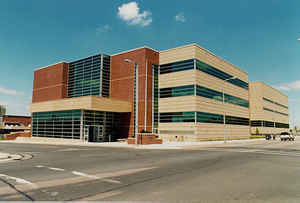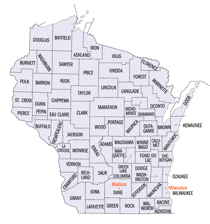Wisconsin Counties
There are seventy-two counties in the state of Wisconsin. Wisconsin became part of the Territory of Michigan and divided into two counties: Brown County in the northeast along Lake Michigan and Crawford County in the southwest along the Mississippi River. The state of Wisconsin was created from Wisconsin Territory on May 29, 1848, with 28 counties.La Crosse County, Wisconsin
La Crosse County Education, Geography, and History

La Crosse County is a county located in the state of Wisconsin. Based on the 2010 census, the population was 114,638. The 2014 estimate
places the county's population at 118,011. Its county seat is La Crosse.
La Crosse County is included in the La Crosse-Onalaska, WI-MN Metropolitan Statistical Area and is the largest populated county on Wisconsin's
western border.
Etymology - Origin of La Crosse County Name
The name of La Crosse is of pure French origin. When the French explorers and traders ascended the Mississippi River...., they saw the Indians playing a game on the prairie that stretched two miles eastward from the bluffs. This was a ball game played with a long handed racquet that reminded the French of their tennis game which they called "la crosse". (This name had its orgin in the fact that the racquet resembled a bishop's crozier. p. 7 of La Crosse county historical sketches, series 2.)
John W. Hunt's 1853 Wisconsin Gazetteer
"PRAIRIE LA CROSSE, is the name given to the beautiful prairie at the mouth of La Crosse river, it was formerly an Indian trading station, and was frequented by them for the purpose of playing their favorite game of ball, from which fact the river now known as La Crosse river, derived its original name of Ball river."
[Source: Card file at the WHS Library reference desk]
Demographics:
County QuickFacts: CensusBureau Quick Facts
La Crosse County History
La Crosse County, created in 1851 from previously unorganized territory, is named for the Native American game "lacrosse." Its county seat is La Crosse
John W. Hunt's 1853 Wisconsin Gazetteer
"LA CROSSE, County, is bounded on the north by Chippewa, on the east by Portage, Adams, and a portion of Sauk, and on the west by the Mississippi, by which it is separated from the territory of Minnesota. This county was set off from Crawford, and organized March 1, 1851, the seat of justice being establisled at La Crosse, on a beautiful prairie of the same name, on the eastern bank of the Mississippi, 90 miles above the junction of the Wisconsin, and on the line between townships 15 and 16 north. It is watered by Black and La Crosse rivers, and Mormon, Eagle and Billings' creeks, and the headwaters of the Lemonwier. Many of the streams are of pure water, with abundance of hydraulic power, abounding with speckled trout. The soil may be considered as first rate, and is mostly of vegetable mould, mixed with a sufficient quantity of sand to give it warmth. In the northeastern portion of the county is a heavy growth of pine timber, which is manufactured into lumber and shingles, the export of which amounts to $175,000 per annumn. Near the head of some of the large streams are cranberry marshes, yielding in good seasons several hundred bushels per acre. The population in 1850, all of which was confined to Black river, was 460. In 1851, about 46,000 acres of school lands, known as a part of the 500,000 acre grant, was brought into market upon very reasonable terms, and many of the enterprizing and industrious inhabitants of the older counties have changed their residence to one in this. The increase of population has probably been greater during the last two years than in any other locality in the State."
[Source: Hunt, John W. Wisconsin Gazetteer (Madison, 1853)]
LACROSSE.
From: Handbook of Wisconsin by S. Silas, 1855
pg. 79-80
La Crosse has recently attracted more attention than other Counties, from the fact of its being on the Western
terminus of the La Crosse and Milwaukee Rail Road. Settlers have been attracted there, because the soil is good, and
affords good encouragement to agriculture. Its future prospects for prosperity are founded on the expectation of the
advantages to be derived from the opening of the Rail Road above alluded to, and its present situation on the
Mississippi, which affords it conveyance for all its surplus products, and its occupying the mouth of Black River,
down which the lumber floats to the Mississippi. A lumber field is as sure to make market for produce and
merchandise as a New England factory, and is more certain of being an open market at all times.
The village of La Crosse occupies just such a position for trade, which has called in a population rapidly. It is
situated on a high, rolling, and somewhat broken prairie, from 25 to 40 feet above high water mark on the
Mississippi River. The prairie is six or seven miles long, and three or four wide, with a light sandy soil, well
adapted for gardening and the growth of shrubbery. It is situated at the mouth of the La Crosse River, and through
the broad valley above the town, also, comes down one of the chutes of the Black River, and this is therefore the
natural outlet of both. The place, like many others in the State, lacks a good hotel, and if there ever be another,
we are sure travelers will avoid the Mississippi House, at least if they are desirous of decent treatment.
Geography: Land and Water
As reported by the Census Bureau, the county has a total area of 480 square miles (1,243 km2), of which, 453 square miles (1,173 km2) of it is land and 27 square miles (70 km2) of it (5.66%) is water.
Neighboring Counties
Bordering counties are as follows:
- Trempealeau County - northwest
- Jackson County - northeast
- Monroe County - east
- Vernon County - south
- Houston County, Minnesota - southwest
- Winona County, Minnesota - west
Education







